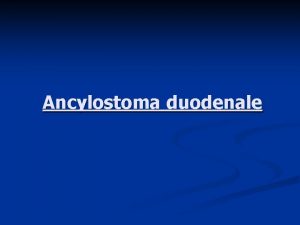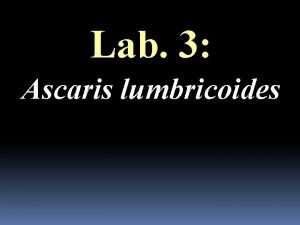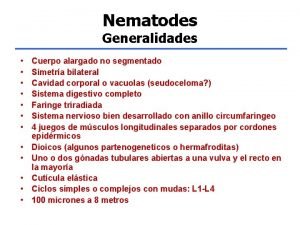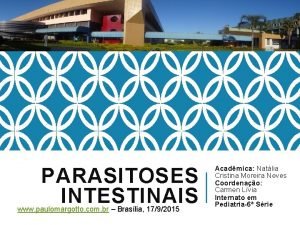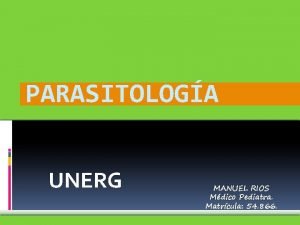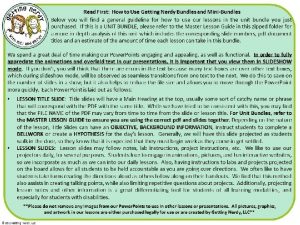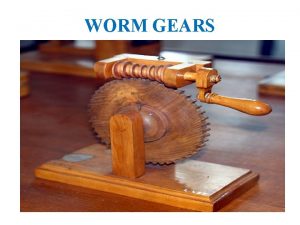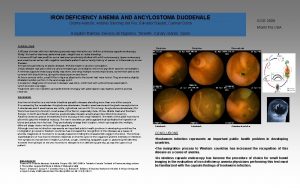Ancylostoma duodenale Commonly called as hook worm Worm









- Slides: 9

Ancylostoma duodenale • • Commonly called as hook worm Worm present in intestine Sucks blood and host becomes anaemic Diarrhoea stomachache Prevention and control Wear shoes and proper disposal of faeces Sanitary habits

Wuchereria bancrofti • It is commonly known as ‘Filaria worm’found in the lymphatic vessels, muscular tissues and glands of man. • The worm is distributed in all tropical, sub tropical and temperate countries and causes filariasis. • Intermediate host is a mosquito (culex fatigans). • It feeds on blood and lymph of human beings. • The female Filaria gives rise to juveniles called Microfilariae. • When mosquito bites the infected person these juveniles reach the mid gut of the mosquito along with blood.

• Disease: In the severe infection due to repeated inoculation the adult cause blocking of lymphatic system which results in the enlargement of legs, arms, scrotum and mammary glands which is known as elephantiasis. It causes filarial fever and headache. • Prevention and control: the most effective preventive means is to avoid the mosquito bite. Mosquito breeding should also be controlled by all means. No proper drug has been invented to eradicate the filaria worms. Heterazon and cyanine is effective to a certain extent.

Dracunculus medinensis • It is also a commmon human nematoda parasite, known as the “Guinea worm”. The “fiery serpents” which molested the ancient israelites of Biblical times are supposed to be the guinea worms. • One of major water borne diseases, transmitted by drinking water containing cyclops. • It is found in regions of Africa, Arabia, pakistan , iran, Turkey, India, China, South America, Guianas etc. • It grows up to 120 cm in length and 1 to 1. 7 mm in diameter. The adult worms live under the deeper layers of skin especially that of the arms, shoulders and legs of their helpless human victims and look like a much coiled varicose vein.

• Disease: The infection of guinea worm causes itching, diarrhoea, nausea, vomiting eosinophilia due to the toxic secretions of the parasite in the body. • Prevention and control: The drug for the treatment of infection is the injection of phenothial zinc emulsified in the olive green.

Enterobius vermicularis • Commonly known as ‘pin worm’ most common parasite f man. • It is cosmopolitan and more common in america, Europe, Africa and Canada. • It is an intestinal parasite but also found in the appendix , caecum and the neighbouring parts of the intestine. • Disease: infection causes restlessness, nervousness, appendicitis, hysteria and inflammation of mucous membrane. • Prevention and control: Good sanitary habits have control on the reinfection of worms. Most effective drug is piperazine to control the infection.

Trichinella spiralis • Trichinella spiralis or “trichinia worm” is another dreaded nematode parasite of man causing the serious disease trichinosis. • Commonly found in Europe, United States and Arctic regions. • Parasite inhabits the intestine of man, pig, rats, and other vertebrates. • Male and female measure 1. 4 to 1. 6 mm and 3 to 4 mm in length, respectively. • Adults lie buried in the mucosa of the host. In humans cysts undergo calcification and larva may die.

• Disease: Trichinosis. The symptoms of the disease are diarrhoea, nausea, abdominal pain, muscular pain etc. • Man usually receives infection by eating partly cooked pork containing very minute cysts. • Prevention and control: There is no effective known treatment, but once the larva have become encysted and calcified in the muscles, most symptoms slowly reduce. • Consumption of properly –cooked pork and all pork products protective against the parasite.

